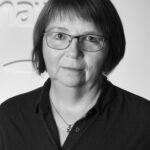Biodiversity in the hot springs at Krafla and Námafjall
This study of ecosystems in hot springs in the thermal areas at Krafla and Námafjall is the fourth phase of the project on ecosystems in thermal areas in Iceland, which is part of the Framework Plan for the utilization of hydropower and geothermal energy in high-temperature areas. Results from similar studies in the Hengill area (2005), Torfajökull area (2006) and Krísuvík (2007) have already been submitted. A total of about 20 samples of liquid, soil or biomass were taken and the species composition was analyzed in 13 of them by partial differentiation of 16S rRNA. The predominant species in the Krafla samples were primitive and chemically active of the divisions Aquificae and β-Proteobacteria. Samples from Jarðbaðshólar were more diverse and were divided into the divisions Actinobacteria, Acidobacteria, Firmicutes, photosynthetic Cyanobacteria and Deinococcus-Thermus. Given the diversity of samples and sampling sites, it was not surprising that species composition varied. Most of the species found are also found in other hot springs in the world. New bacterial species were found in several samples, including the primitive Hydrogenobacter species in a sample from wastewater from a separation station at Krafla. In addition, two new species of β-proteobacteria were found. Three new species of γProteobacteria were found, one in Grjótagjá, another in a soil sample by the steam eye in Jarðbaðshólar and the third in a drainage stream in Krafla. A new species of the Meiothermus genus was found in Jarðbaðshólar and finally one distant (92%) Thermus species. One closely related species (≥98%) species Thermus aquaticus was found in a sample of the Krafla area, but this species has been considered endemic in the United States. Biodiversity in the samples was estimated to be in the range of 1.0 - 5.8 on a scale of 1-10, but it is common for the value to be in the range of 1-2 in samples from peripheral ecosystems where the environmental impact is high. The value was very low in several samples in the study, or 1.04 in a soil sample from Suðurhlíðar Krafla, 1.2 in a liquid sample from a drainage stream in Krafla, 1.0 in a clay spring at Víti and 1.1 in a liquid sample from the Blue Lagoon in Bjarnarflag. Biodiversity was considerably higher in samples from Grjótagjá (3,4) and Jarðbaðshólar (4,8-5,2), which is not surprising as environmental conditions were more favorable for more species. Hot water samples were scanned for 72 elements (ICP_MS). It is hoped that in the future it will be possible to link elemental measurements with results from species composition in samples.
This project on microbial diversity in hot springs in the Krafla and Namafjall geothermal areas is within the Framework of Utilization of Geothermal power of high temperature geothermal areas in Iceland. Other areas studied so far are the Hengill area (2005), Torfajökull area (2006) and Krísuvik area (2007). Twenty samples were taken from liquid, soil or biomass. Partial sequencing of 16S rRNA genes from the samples was used to estimate species composition in the samples. Species composition was estimated in 13 samples. Dominating species within the Krafla samples were chemolithoautotrophic species of Aquificae and β-Proteobacteria phyla. In Jarðbaðshólar samples, the species were more diverse and belonged to the Actinobacteria, Acidobacteria, Firmicutes, Cyanobacteria and Deinococcus-Thermus phyla. This was not surprising as sample types and sample sites were diverse in character. Most species found in this study were known from other geothermal areas in the world. Novel species were found in several samples: A chemolithoautotrophic Hydrogenobacter species was found in an effluent from the powerplant in Krafla. Two new species of β-Proteobacteria were also found in the samples. Three novel species of γ-Proteobacteria were found, one in Grjótagjá, one in Jarðbaðshólar and one in the Krafla effluent. A novel species of the genus of Meiothermus was found in Jarðbaðshólar. Finally one species, a distant (92%) relative of Thermus spp. A close (≥ 98%) relative of Thermus aquaticus was found in one sample from the Krafla area, but this species has hitherto been confined to the USA. A biodiversity index of the samples was calculated between 1.0-5.8, but a value of 1-2 is common in samples from extreme ecosystems were environmental pressure is high. This value was quite low in several samples ie 1,04 in a soil sample from the southern hills of Krafla, 1,2 in a liquid sample from the Krafla effluent, 1,0 in a geothermal mudsample from Víti and 1,1 from a liquid sample from the Blue Lagoon in Bjarnarflag. Calculated biodiversity index in samples from Grjótagja and Jarðbaðshólar was considerably higher which is not surprising as environmental conditions were favorable to a higher number of species. Water samples from hot springs were scanned semi quantitatively for 72 elements and analyzed with ICP-MS. In the future we hope to be able to connect data from element analysis to results of species composition.


